Menu
-
0 items in quote
No products in the Quote Basket.
9 am to 6 pm PST time
No products in the Quote Basket.
SMART CUT® Sintered (Metal Bond) Diamond Carving Points are engineered for precision carving, shaping, and engraving across a wide range of ultra-hard to soft materials. Unlike electroplated diamond carving points, which lose effectiveness once the outer diamond layer wears away, SMART CUT® sintered diamond carving points feature diamond crystals distributed throughout the entire cutting tip. This ensures continuous cutting performance for the entire lifespan of the tool. As long as any portion of the diamond head remains, the tool continues to deliver superior results. Designed for use with all popular handheld machines, these carving points must be used with coolant for optimal performance and longevity.
Manufactured using an advanced high-pressure, high-temperature sintering process SMART CUT® Diamond Carving Points permanently fuse diamond particles with a durable metallic matrix. This advanced bonding technology eliminates common issues found in electroplated tools, such as diamond pull-out and peeling, ensuring exceptional structural integrity and long-term cutting efficiency. The diamond head maintains its precise shape, allowing for fast, effortless cutting with superior control and accuracy.
One of the standout features of SMART CUT® Sintered Diamond Carving Points is their self-renewing cutting surface. As the tool wears, new layers of sharp diamond grit are continuously exposed, preventing dulling and maintaining a consistent cutting rate. Unlike electroplated tools that become ineffective once their outer layer wears down, SMART CUT® diamond carving points stay sharp throughout their entire lifespan. They can also be easily re-sharpened by dressing against a wet dressing stone at 4,000 RPM for 15 seconds, further extending their usability and ensuring peak cutting performance. Pre-dressing before first use enhances efficiency and cutting precision.
These carving points deliver an exceptionally smooth and refined surface finish, reducing the need for secondary grinding or polishing. Their uniform diamond distribution ensures clean, precise cuts, making them ideal for intricate carving, engraving, and shaping applications where high precision is required.
Built for extreme durability, SMART CUT® Sintered Diamond Carving Points last significantly longer than other carving tools. They offer a 30 to 100 times longer lifespan than electroplated diamond tools, which lose effectiveness once their thin outer diamond layer is depleted. Compared to standard silicon carbide or aluminum oxide abrasive points, they can last up to 100 times longer, while generating less grinding dust. With proper maintenance and coolant use, SMART CUT® carving points maintain their cutting power for years, reducing tool change frequency and lowering overall operational costs.
Despite their higher initial cost, SMART CUT® Sintered Diamond Carving Points provide the best long-term value by significantly reducing replacement frequency and downtime. Their self-renewing cutting action ensures continuous performance, making them the ideal choice for demanding applications involving metal, porcelain, glass, ceramics, composites, and stone. They cut efficiently with minimal applied force, reducing operator fatigue, while their clean cutting process results in a healthier and safer work environment with less airborne dust. Over a hundred different shapes, diameters, grit sizes, and bond harnesses are available as standard. And almost any custom specification can be produced with no minimum order quantity.
For professionals seeking maximum precision, durability, and cost-efficiency, SMART CUT® Sintered Diamond Carving Points deliver unparalleled performance. With their ability to maintain a consistent cutting rate, hold their shape over time, and work seamlessly with all handheld machines when used with coolant, they are the ultimate choice for high-precision carving and grinding applications. Experience the industry-leading performance of SMART CUT® Sintered Diamond Carving Points today.
Hand Piece Drills, Cordless Drills, & Other Equipment (must be used between 9,000 to 35,000 RPM’s (do not
exceed
35,000 RPM)
Diamond Sizes Available: 40 microns (500 mesh) to 230 microns (65 grit)
Typically in Stock: 70 microns (240 mesh), 80 microns (210 mesh), 110 microns (150 mesh), 160
microns (90 mesh), 230 microns (65 mesh)
d – Outside Diameter of Carving Point in Millimeters
L – Diamond Height (depth) of each carving point in Millimeters
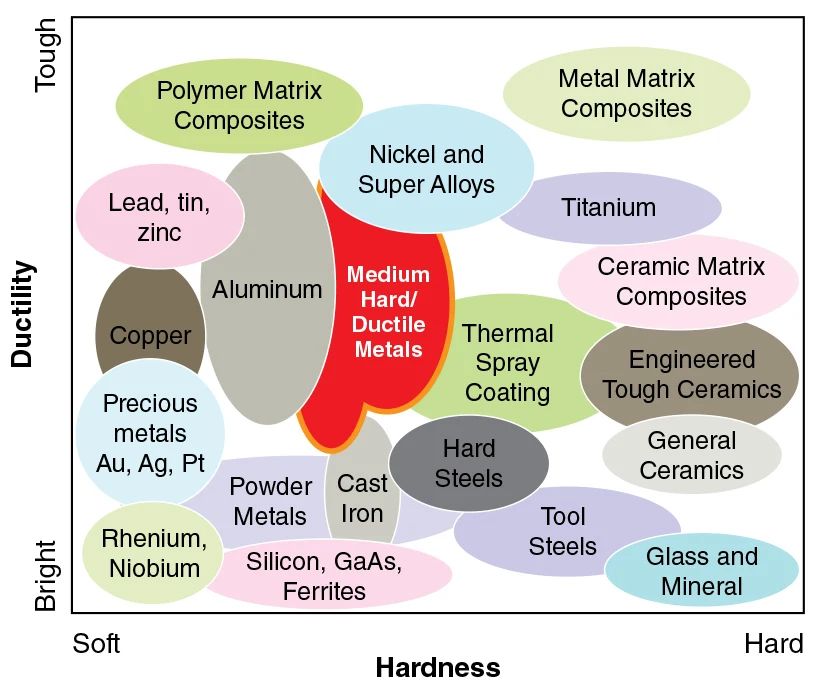
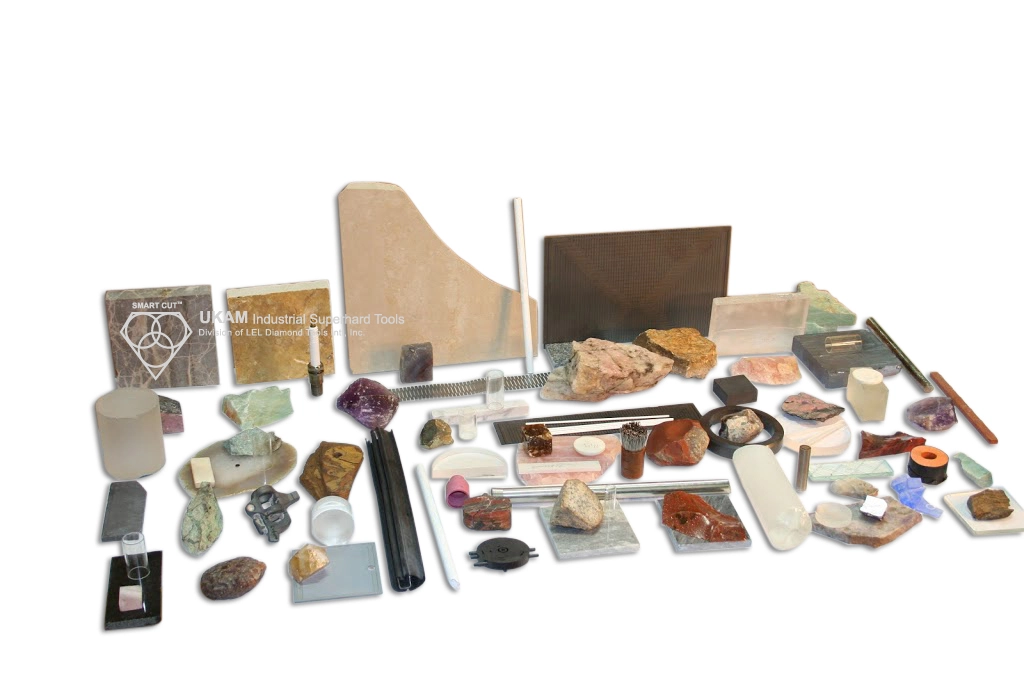
INDUSTRIES USED IN:
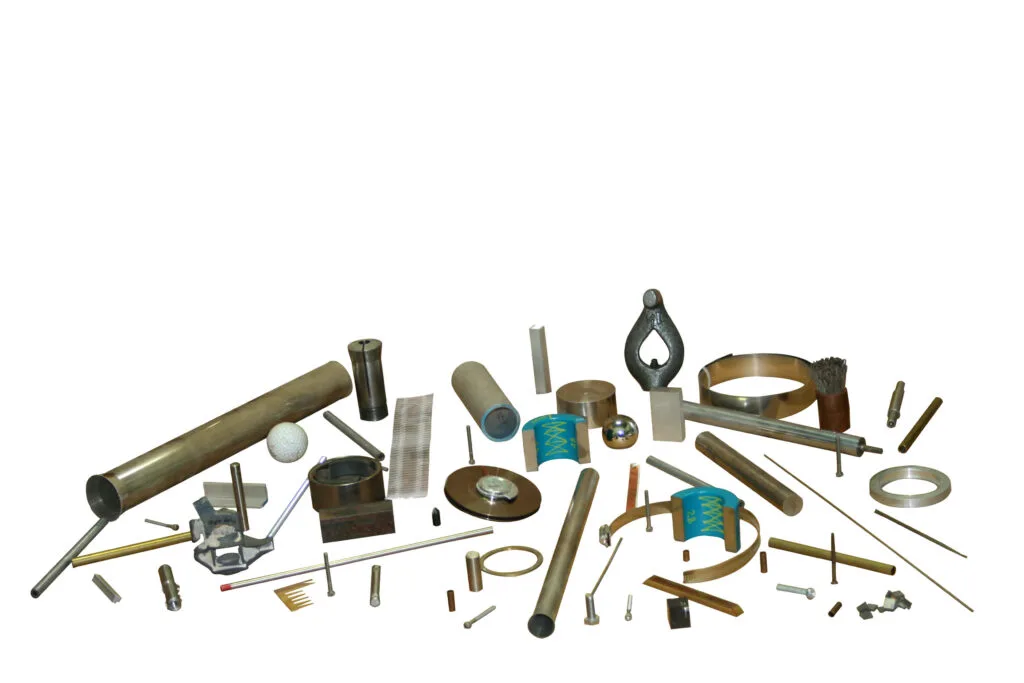
Ferrous & Non-Ferrous Metals:
Sintered diamond carving points are tools for carving a wide range of materials, from ultra-hard to soft, into detailed shapes. They feature diamond particles bonded with metal, processed under extreme conditions for durability and efficiency.
Unlike electroplated diamond points, sintered ones embed diamond particles throughout the point, ensuring longevity and consistent performance. The diamond section doesn’t strip or peel, avoiding diamond particle loss common in electroplated tools.
These carving points are compatible with hand piece drills, cordless drills, and other similar equipment. They require coolant and should be operated at 9,000 to 35,000 RPMs, without exceeding 35,000 RPMs.
They are ideal for glass/quartz, advanced ceramics, natural stone & gemstone, composites, and metals.
Diamond sizes range from 40 microns (500 mesh) to 230 microns (65 grit), with common stock sizes including 70, 80, 110, 160, and 230 microns.
Specify the tool number, materials to be used on, desired diamond size, and shank size. The minimum order value is $100 USD.
Yes, customization options include any diameter, shank size, length, grit size, and shape.
They are recommended for materials rated from 45 to 75 on the Rockwell Scale (5 to 9.5 on Mohs scale of hardness).
The metal bond wears away gradually, continuously re-exposing the diamonds for effective cutting.
These points generally last longer than other diamond carving/shaping tools, offering superior durability and consistent performance.
Yes, they are designed for superior longevity. The metal bond design ensures that diamonds are continuously exposed for cutting, making them more durable compared to electroplated tools.
Coolant is crucial for preventing overheating and ensuring smooth operation. It also prolongs the life of the carving point and enhances the quality of the cut.
Absolutely. Sintered diamond carving points are ideal for intricate and detailed work due to their precision and the variety of shapes and sizes available.
The choice of grit size depends on the material you are working with and the desired finish. Finer grits are used for smoother finishes, while coarser grits are for more aggressive material removal.
No, the sintering process ensures that the diamond section is firmly bonded and will not strip off or peel, unlike in some electroplated tools.
While they are professional-grade tools, they can be used by anyone who requires precision and quality in their material carving, from professionals to hobbyists.
Store them in a dry, safe place away from direct sunlight and moisture. Regularly clean and inspect them for wear and tear. Always use them within recommended RPM limits to ensure longevity.
They should be used on compatible hand piece drills, cordless drills, and other specified equipment. Ensure your machine can operate within the required RPM range.
Custom orders may have additional costs depending on the specifications requested. It’s best to inquire directly for a quote based on your custom requirements.
Warranty or guarantee terms vary depending on the manufacturer or supplier. It’s advisable to check at the time of purchase.
Always wear appropriate safety gear like goggles and gloves. Ensure your work area is well-ventilated, and follow all safety guidelines for your equipment.
Dispose of them according to local regulations for metal and diamond tools. Do not throw them in regular trash due to the metal and diamond components.
Generally, these points are not designed to be resharpened. The diamond particles are consumed during use, and once worn out, the tool should be replaced.
Select a shank size that fits securely in your equipment’s chuck. Standard sizes are 3/32” (2.35mm), but 1/8” and ¼” sizes are available for different machine compatibilities.
While they are professional-grade, beginners can use them with proper guidance and adherence to safety protocols. They offer precision that might be beneficial for learners.
Using a carving point beyond its recommended RPM limit can lead to tool damage, decreased efficiency, and potential safety hazards.
Yes, they can be used on a range of materials from ultra-hard to soft. However, the technique and grit size might vary based on the material’s hardness.
Lead times for custom orders depend on the complexity and volume of the order. It’s best to consult with the manufacturer for an accurate timeframe.
Avoid using these tools on materials that can cause excessive wear or damage, such as certain extremely hard or abrasive materials. Consult with the manufacturer if unsure.
Signs of wear include reduced cutting efficiency, visible wear on the diamond section, and changes in the tool’s performance. Replace the tool when these signs are evident.
Yes, in fact, using them with coolant (wet conditions) is recommended to prevent overheating and to prolong the tool’s life.
Stop using the tool immediately and carefully remove any broken pieces. Inspect your equipment and workpiece for damage. Always replace a broken tool rather than trying to repair it.
Choose a carving point with a suitable diamond grit size for the material’s hardness. Harder materials require finer grits for effective cutting.
Store them in a cool, dry place, away from extreme temperatures and moisture. Proper storage prevents corrosion and maintains the tool’s integrity.
Yes, different materials may require different speeds for optimal cutting. Refer to material-specific guidelines or consult with the manufacturer for recommendations.
They can be used on standard drills, provided the drills can accommodate the shank size and operate within the recommended RPM range.
While there’s no specific type of coolant mandated, it’s important to use a coolant that’s suitable for both the tool and the material being worked on. Water or water-based coolants are commonly used.
Not using coolant can lead to overheating, decreased tool life, and potential damage to the material being worked on. It also increases the risk of tool failure.
The right diamond size depends on the material hardness and the desired finish. Finer diamond sizes are better for harder materials and finer finishes.
Safety standards can vary based on the region and the manufacturer. It’s best to check with the supplier or manufacturer for specific compliance information.
Excessive pressure can lead to premature wear and potential breakage. It’s important to use the tool with steady, moderate pressure for best results.
While they are primarily designed for wet use (with coolant), some may be suitable for dry applications. Check the manufacturer’s guidelines before use.
The service life varies based on usage, material worked on, and adherence to operating guidelines. Regular maintenance and proper use can significantly extend their lifespan.
Clean them with a soft brush and mild detergent, and dry thoroughly after use. Regular cleaning helps maintain efficiency and prevents buildup of material residues.
They are made with metal and diamonds, which are not biodegradable, but they offer longer life spans than many alternatives, reducing waste. Dispose of them properly at the end of their life cycle.
While primarily designed for materials like glass, ceramics, and stones, consult the manufacturer for suitability with other materials.
Extremely high temperatures can affect the metal bond and diamond integrity. Using coolant helps mitigate this risk.
Return policies vary by supplier. Contact the supplier directly for their specific return process and policies.
Using these tools effectively often involves a combination of steady hand control, correct speed, and appropriate pressure. Practice and experience enhance skill and technique.
Check for brand markings, purchase from reputable suppliers, and look for certifications or quality marks that indicate authenticity.
Yes, these carving points come in various shapes to suit different carving needs, including cylindrical, conical, spherical, and more specialized forms.
Shank length determines how deep you can carve or drill into a material. It’s important to choose a length that’s appropriate for your specific task.
Start by using it on a scrap piece of material similar to your project material. This allows you to gauge its performance and make any necessary adjustments.
Generally, these tools are designed to be universally compatible with machines that can accommodate their size and RPM requirements.
Choose sintered points for longer life and durability, especially for harder materials. Electroplated points may be suitable for softer or less frequent use.
Shank diameter affects the tool’s stability and compatibility with your equipment. A properly fitting shank is essential for safe and effective operation.
They can be used at various angles, but it’s important to maintain control and proper alignment to avoid tool breakage and ensure effective carving.
If overheating occurs, stop using the tool immediately. Check the coolant system for proper function and ensure you’re operating within the recommended RPM range.
Store these tools in a dry, secure place. Dedicated tool storage kits or containers are recommended to protect them from damage and environmental factors.
If the tool causes material cracking, reassess the tool’s suitability for the material, the applied pressure, and the operating speed. Adjust your technique or tool choice as necessary.
Using the right coolant can significantly extend the tool’s lifespan by reducing heat and friction, which are major causes of wear.
Recycling options depend on local recycling capabilities. Contact local waste management services for advice on recycling metal and diamond tools.
Many manufacturers and suppliers offer instructional materials or training sessions. Check with your supplier or online resources for guidance.
Refer to the manufacturer’s guidelines for speed settings. Generally, harder materials require lower speeds to prevent overheating and ensure precision.
Ensure the equipment is turned off and unplugged. Use appropriate tools to change the carving points to avoid injury.
Yes, they are suitable for engraving due to their precision and ability to handle various materials.
Inspect the tool for visible signs of wear, such as reduced diamond grit or changes in shape. Decreased performance is also an indicator.
Signs include rapid wear, poor cutting performance, and diamonds coming off the tool prematurely.
Finer grit sizes result in a smoother finish, while coarser grits are used for more aggressive cutting and rougher finishes.
Do not force the tool to fit. Check for compatible shank sizes or consider using an adapter if available and safe.
It’s advisable to give periodic breaks to prevent overheating, especially during extensive use.
Using these tools at higher speeds can lead to tool breakage, decreased effectiveness, and potential safety hazards.
The shape depends on the type of carving or engraving. Cylindrical shapes are versatile, while pointed shapes are good for detailed work.
Extreme temperatures and humidity can affect the metal bond and overall integrity of the tool. Store and use them in a controlled environment when possible.
While primarily designed for harder materials, consult the manufacturer to determine suitability for softer materials like wood or plastic.
Common mistakes include using incorrect speed settings, applying excessive pressure, and using the tool for unsuitable materials.
Dispose of broken tools according to local regulations for sharp and metal objects. Do not throw them in regular trash.
For very hard materials, use lower speeds and apply steady, light pressure. Patience and gradual progress are key to avoid tool damage.
Larger diameters are suitable for broader cuts or carves, while smaller diameters allow for finer, more detailed work.
Yes, using a variety of carving points can be beneficial for projects requiring different levels of detail and types of cuts.
Check for any visible defects, ensure the diamond grit is evenly distributed, and that the tool fits securely in your machine.
If you experience excessive vibration, check the tool’s fit in the machine, the balance of the carving point, and ensure you’re using the correct speed.
Plan your work, start with larger cuts and gradually move to finer details. Use appropriate shapes and sizes of carving points for different aspects of the task.
Yes, if the lathe can accommodate the shank size and operate within the tool’s RPM range, they can be used for detailed lathe work.
Consider factors like reputation, quality of materials, range of products, customer reviews, and after-sales support.
Manufacturing time varies but can range from a few days to several weeks, depending on the complexity and quantity of the order.
In educational settings, emphasize safety, proper usage techniques, and supervision, especially for beginners or students.
Yes, they are suitable for micro-carving, provided you select the appropriate size and shape for the fine details.
While highly durable, they have limitations in terms of the materials they can effectively work on and may be less effective on extremely hard or abrasive materials.
Maintain them properly, use them within recommended guidelines, and replace them when signs of significant wear are noticed.
A shank size that fits well with your machine ensures better control and stability during use, reducing the risk of errors and accidents.
Yes, by selecting appropriate grit sizes and shapes, these tools can be used for both roughing out material and for finishing details.
Refer to the manufacturer’s guidelines or consult with an expert. Generally, harder materials require finer grits and vice versa.
Wear safety glasses, gloves, and hearing protection, especially when working on harder materials that can produce debris or high noise levels.
Regularly clean the tool, ensure it’s used at the correct speed and pressure, and replace it when it shows signs of wear.
Generally, these tools cannot be repaired once damaged due to the way the diamond particles are embedded in the metal bond.
Avoid applying excessive force, use the correct speed, and choose the appropriate tool for the material and task to prevent breakage.
Different materials require different grit sizes and tool shapes. Harder materials need finer grits for efficient cutting, while softer materials can be worked with coarser grits.
No, regular sharpeners are not suitable for sintered diamond tools due to their unique construction and material composition.
Higher RPMs can lead to quicker cutting but may increase the risk of overheating or damage to softer materials. Lower RPMs are safer for harder materials.
The right pressure depends on the material hardness and the tool’s design. Generally, a moderate, steady pressure is recommended.
Sintered diamond carving points are not typically designed to be sharpened. Once they are worn out, they should be replaced.
Dispose of worn-out tools properly as they contain metal and diamonds. Consider environmental regulations for disposing of such materials.
The frequency depends on usage intensity, material hardness, and adherence to recommended operating conditions. Regular inspection will indicate when replacement is necessary.
Yes, they can be used with CNC machines and other automated equipment that can accommodate their shank size and operate within the recommended RPM range.
Working with ultra-hard materials requires precision, the right tool selection, and patience, as these materials can be more demanding on the tools.
Clean with a soft brush and mild detergent, rinse with water, and dry completely. Avoid harsh chemicals that could damage the metal bond.
Absolutely, they are well-suited for detailed crafting and artistic work on a variety of materials.
Turn off the machine immediately and carefully remove the tool and material. Inspect for any damage and determine the cause to prevent recurrence.
Deeper cuts require more pressure and can cause more wear on the tool. It’s important to balance the depth of cut with the tool’s capabilities and the material’s properties.
To prevent corrosion, store the tools in a dry environment and avoid exposure to corrosive substances. Proper cleaning and maintenance also help prevent corrosion.
To ensure their longevity, use them within their specified RPM range, apply appropriate pressure, use them with the correct coolant, and store them properly when not in use.
Consider the material hardness, desired precision, tool size and shape, and the type of detail or finish required for the job.
Tool chatter is often a sign of incorrect speed, poor tool fit, or inappropriate pressure. Adjust these factors to reduce chatter.
Yes, they are excellent for sculpting, offering the precision and durability needed for working with various sculpting materials.
Use a finer grit, lower pressure, and slower speed to reduce the risk of damaging fragile materials.
Humidity can lead to rust or corrosion of the metal parts. Store the tools in a low-humidity environment to protect them.
Signs include poor cutting performance, excessive tool wear, or damage to the material. If these occur, consider a different tool or technique.
Yes, but beginners should start with simpler tasks and follow all safety guidelines while gaining experience and skill.
Heavier tools may offer more stability but can be more tiring to use. Choose a tool weight that is comfortable and suitable for your application.
Using worn-out tools can lead to poor performance, lower quality of work, and increased risk of tool breakage.
Plan the project, start with broad cuts, and gradually move to finer details. Use a variety of tool shapes and sizes as needed.
Yes, they can be used alongside other types of carving tools for different stages or aspects of a project.
Store them in a dedicated tool organizer or container, each in its own slot, to prevent damage and keep them easily accessible.
For engraving, choose finer, more precise tools. For broader carving, choose tools with larger diameters and appropriate shapes.
These tools are widely used in industries such as jewelry making, precision engineering, glasswork, and stone carving.
Carving depth should be determined based on the material’s hardness, desired outcome, and the tool’s capabilities. Test on a small area first to gauge the appropriate depth.
Always wear protective gear, ensure the work area is secure, and use clamps or holders to keep the material steady. Avoid wearing loose clothing or jewelry that could get caught in the machinery.
Use dust extraction systems or work in well-ventilated areas. Wearing a mask is also advisable to protect against inhaling fine particles.
Use carving points with appropriate shapes for curves and angles, and adjust your hand position and tool angle for precision.
Yes, they are suitable for relief carving due to their precision and ability to create varying depths and textures.
Use coolant, operate at the correct speed, and take breaks during prolonged carving to allow both the tool and material to cool down.
For large pieces, use tools with larger diameters and longer shanks. For small or detailed pieces, opt for finer tools with smaller diameters.
Different shapes are suited for different types of cuts and details. For example, cylindrical shapes are good for general use, while pointed shapes are better for detailed work.
Yes, but consider the different hardness of each layer, and adjust the carving technique and tool choice accordingly.
Lifespan depends on usage, material hardness, and adherence to operating guidelines. Regular inspection and noticing a decrease in performance can indicate it’s time for replacement.
Sintered diamond tools are not typically designed to be sharpened; they are replaced once they become dull or inefficient.
Practice steady hand control, maintain correct tool angles, and use the appropriate speed and pressure for accuracy.
If marks or scratches occur, reassess the tool’s grit size, the applied pressure, and ensure it’s the correct tool for the material type.
Use noise reduction equipment like ear protection, operate at lower speeds when possible, and ensure the tool is properly fitted and balanced to reduce vibration and noise.
When working with composites, be aware of the differing properties of the composite materials and adjust the carving technique and tool choice accordingly.
Start with coarser grits for roughing out material, then switch to finer grits for detailed finishing work.
Regular cleaning, proper storage, and using them within their operating guidelines are key to maintaining these tools.
While primarily designed for carving, some sintered diamond carving points may be suitable for drilling, depending on their shape and size. Check with the manufacturer for specific recommendations.
Grit size refers to the size of the diamond particles embedded in the carving point. It determines the coarseness or fineness of the tool.
Grit size affects the tool’s cutting ability, the finish of the carved material, and the speed of material removal. Different grit sizes are suited for different materials and types of work.
Consider the material hardness and the desired finish. Use finer grits for harder materials and a smoother finish, and coarser grits for softer materials and rapid material removal.
For hard materials like stone or glass, finer grit sizes (such as 70 to 230 microns) are typically more effective for precise and smooth carving.
Yes, a coarser grit removes material faster but provides a rougher finish. It’s suitable for initial shaping before moving to finer grits for detailed work.
It’s not recommended as different materials respond better to specific grit sizes. Adjust the grit size according to the material’s hardness and the carving detail required.
Finer grits may wear down slower than coarser grits but might require more time to achieve the desired result. Coarser grits may wear faster due to more aggressive material removal.
For detailed or fine work, use a finer grit size to achieve precision and a smooth finish without damaging the material.
Yes, you can start with a coarser grit for rough shaping and switch to a finer grit for finishing and detailing.
For softer materials, a coarser grit size can be effective. However, be cautious to avoid too much material removal or damaging the piece.
If the material is not being shaped effectively, or if the surface finish is not as desired, you may need to adjust the grit size.
While there are common practices, the choice of grit size can vary based on personal preference and specific project requirements.
Coarser grits generally allow for faster carving, while finer grits are used for slower, more detailed work.
To achieve a polished finish, progressively move to finer grits and consider finishing with a polishing tool or compound.
Yes, it’s common to use different grit sizes for roughing out, shaping, and finishing stages to achieve the best results.
For engraving, finer grit sizes are typically better for detailed lines and precision. For broader carving work, coarser grits may be more effective.
Not always. While finer grits yield a smoother finish, they also work slower. The best grit is a balance between the desired finish and efficient work speed.
Finer grits often have a slower wear rate as they remove material more gently, while coarser grits may wear faster due to aggressive cutting.
Composite materials often require mid-range to finer grits, depending on the material’s hardness and the desired finish.
Different types of stone may require different grit sizes, depending on their hardness and the carving detail required.
Very important. Finer grits are typically preferred for glass to prevent chipping and to achieve a smooth finish.
If the material chips or fractures, consider switching to a finer grit size, and ensure you are using the correct speed and pressure.
Yes, coarser grits may produce more debris and dust. Always wear appropriate safety gear, regardless of grit size.
Test the carving point on a scrap piece of the same material before starting the actual project to assess its effectiveness.
For roughing out, start with a coarser grit to remove material quickly, then move to finer grits for shaping and detailing.
Finer grits are generally preferred for metals to achieve a smooth finish and to prevent excessive material removal.
It’s possible, but the finish will be rougher. For a smooth finish, finer grits are necessary.
With coarser grits, use lighter pressure to prevent excessive material removal. With finer grits, use steady pressure and slower movement for a smooth finish.
Jewelry making often requires a range of grit sizes, from coarser for shaping to finer for detailed work and finishing.
Finer grits offer greater control for detailed work, while coarser grits may be harder to control due to their aggressive cutting action.
For curved surfaces or intricate designs, finer grits are generally better as they allow for more precision and detail.
No, typically, harder gemstones require finer grits for precision without damage, while softer stones can be worked with coarser grits.
Move to a finer grit when the basic shape is established, and you need to refine the details and smooth the surface.
Coarser grits are usually better for creating textures, as they remove more material and create more pronounced patterns.
The principle remains the same for both dry and wet carving, but wet carving often allows for using slightly coarser grits as the water reduces dust and cools the tool.
Coarser grits generally produce more dust and debris compared to finer grits, which remove material more gently.
If you start with a grit that’s too coarse, switch to a finer grit as soon as possible to avoid further roughening the surface.
While there are standard grit size charts, the best grit size can vary based on specific project requirements and material properties.
For a balance between speed and finish, start with a medium grit to quickly shape the material, then switch to a finer grit for finishing.
Finer grits are effective for removing tool marks and smoothing the surface, especially in the final stages of carving.
For ceramics, start with a medium to fine grit for shaping without causing cracks, then use finer grits for finishing.
A mirror finish usually requires very fine grits and may need additional polishing steps with specialized tools or compounds.
Coarser grits can generate more heat due to rapid material removal, while finer grits tend to generate less heat but may require more time to work.
For a satin finish on metals, start with a medium grit for initial shaping, followed by finer grits to achieve the desired smoothness and texture.
Yes, using a combination of different grit sizes can create unique textures and effects in your carving project.
Switch to progressively finer grits to remove deep scratches and smooth the surface, carefully working through each grit size.
For restoration, start with a grit size that’s coarse enough to remove old finishes or damage, then gradually move to finer grits for a polished look.
Begin with coarser grits for rough shaping, then incrementally move to finer grits to refine and smooth the surface.
Ensure the carving point is properly attached, and the equipment is adjusted to the correct speed for the new grit size to prevent tool damage or injury.
Medium to fine grits are usually suitable for creating beveled edges, offering a balance between shaping and smoothing the edge.
Work slowly and check your progress frequently to avoid over-sanding, especially when using very fine grits.
Image | Item No. | Description | Price | Quantity | Add to cart |
|---|---|---|---|---|---|
Color: 5/8″-11″ thread. Fits into drill press chuck. Shank adapter threads into 5/8″-11″ female thread of diamond drill. Can be used with any other tool with 5/8″-11″ thread. | $26.72 | Max: Min: 1 Step: 1 | |||
Color: 5/8″-11″ thread. Fits into drill press chuck. Shank adapter threads into 5/8″-11″ female thread of diamond drill. Can be used with any other tool with 5/8″-11″ thread. | $22.46 | Max: Min: 1 Step: 1 | |||
1 Gallon Blue SMART CUT® General Materials Formula Synthetic Water Soluble Coolant | $99.81 | Max: Min: 1 Step: 1 | |||
1 Quart Blue SMART CUT® General Materials Formula Synthetic Water Soluble Coolant | $34.81 | Max: Min: 1 Step: 1 | |||
5 Gallons Blue SMART CUT® General Materials Formula Synthetic Water Soluble Coolant | $317.41 | Max: Min: 1 Step: 1 | |||
55 Gallons Blue SMART CUT® General Materials Formula Synthetic Water Soluble Coolant | $1,745.00 | Max: Min: 1 Step: 1 | |||
1/2″ x 1/2″ x 6.0″ White Recommended for coarser grits found in segment wheels, core drills, or Blanchard grinding. Excellent performance on 120 grit tools. | $8.65 | Max: Min: 1 Step: 1 | |||
1.0″ x 1.0″ x 6.0″ White Recommended for coarser grits found in segment wheels, core drills, or Blanchard grinding. Excellent performance on 120 grit tools. | $15.99 | Max: Min: 1 Step: 1 | |||
1/2″ x 1/2″ x 6.0″ White For use on diamond tools 150 to 220 Grit Size. | $8.65 | Max: Min: 1 Step: 1 | |||
1.0″ x 1.0″ x 6.0″ Black Recommended for use in Diamond Tools 150 Grit Size (mesh size) or finer. | $15.39 | Max: Min: 1 Step: 1 | |||
2.0″ x 2.0″ x 6.0″ Black Recommended for use in Diamond Tools 150 Grit Size (mesh size) or finer. | $39.47 | Max: Min: 1 Step: 1 | |||
1.0″ x 1.0″ x 6.0″ Black Recommended for coarser grits found in segment wheels, core drills, or Blanchard grinding. Excellent performance on 120 grit tools. | $15.99 | Max: Min: 1 Step: 1 | |||
2.0″ x 2.0″ x 6.0″ Black Recommended for coarser grits found in segment wheels, core drills, or Blanchard grinding. Excellent performance on 120 grit tools. | $39.47 | Max: Min: 1 Step: 1 | |||
$154.87 | Max: Min: 1 Step: 1 | ||||
$154.87 | Max: Min: 1 Step: 1 | ||||
$235.00 | Max: Min: 1 Step: 1 |
Safety First
Tool Preparation
Equipment Setup
Material Preparation
Select the Appropriate Carving Point
Detailed Planning
Precise Marking
Test Carving
Install the Carving Point
Set the Correct Speed
Apply Coolant (If Required)
Begin Carving
Initial Carving Stages
Intermediate Shaping
Fine Detailing
Maintain Steady Pressure and Speed
Carve in Stages
Environmental Preparation
Material Conditioning
Initial Rough Carving
Intermediate Detailing
Micro Detailing
Symmetry and Balance Check
Surface Smoothing
Protective Finishing
In-Depth Material Analysis
Optimal Positioning
Depth Control
Regularly Clean the Tool
Comprehensive Design Planning
Gradual Material Removal
Adaptive Carving Strategies
Multi-Angle Carving
Dynamic Pressure Control
Precision in Detail Work
Monitor Tool Temperature
Post-Work Maintenance
Strategic Carving
Angle and Pressure Adjustment
Continuous Assessment
Fine Detailing Techniques
Avoiding Over-Carving
Smoothing and Polishing
Final Touches and Cleaning
Tool Care and Storage
Periodic Tool Maintenance
Final Detailing and Refinement
Regular Breaks
Dust Management
Final Inspection and Adjustment
Finishing Touches
Post-Carving Finishing
Project Documentation
Feedback and Improvement
Finish and Refine
Clean Up
Reflect and Learn
Understand Material Properties: Different materials will respond differently to carving. Understanding your material’s hardness and brittleness is key.
The optimal RPM (revolutions per minute) for using Sintered (Metal Bond) diamond carving points depends on several factors, including the material being carved, the size and shape of the carving point, and the specific project requirements. However, here are some general guidelines to consider:
Soft Materials (e.g., wood, plastic):
Hard Materials (e.g., glass, stone, metal):
Intricate or Detailed Work:
General Carving and Shaping:
It is important to always start with a lower RPM and gradually increase it until you find the optimal speed for your specific project. Additionally, always refer to the manufacturer’s guidelines and recommendations for using Sintered (Metal Bond) diamond carving points, as they may provide specific RPM ranges for their products.
When using Sintered (Metal Bond) diamond carving points, introducing a coolant can help reduce heat, minimize dust, and potentially extend the life of the carving points. Water is typically used as a coolant for this type of application. Here’s how to use and introduce coolant:
Coolant to Use:
How to Introduce Coolant:
Dipping Method:
Spray Bottle Method:
Sponge Method:
The feed rate and pressure to apply when using Sintered (Metal Bond) diamond carving points depend on several factors, including the material being carved, the hardness of the diamond, the size and shape of the carving point, and the specific project requirements. However, here are some general guidelines to consider:
Feed Rate:
Pressure to Apply:
Additional Tips:
Remember that practice and experience are key to finding the optimal feed rate and pressure for your specific projects. It may take some trial and error to find the right balance, but with time and practice, you will develop a feel for what works best.
The shape of the Sintered (Metal Bond) diamond carving point to use depends on the specific project requirements and the desired outcome. Here are some general guidelines to consider:
Cylinder or Cone Shapes:
Ball or Spherical Shapes:
Pointed or Needle Shapes:
Wheel or Disc Shapes:
Tapered Shapes:
Flame Shapes:
Oval Shapes:
Inverted Cone Shapes:
Parallel Shapes:
Custom Shapes:
Rounded Cylinder Shapes:
Tapered Cylinder Shapes:
Elliptical Shapes:
Square or Rectangular Shapes:
Specialty Shapes:
It’s important to consider the size and shape of the area you are working on, as well as the level of detail required for the project. For larger areas and rough shaping, choose a larger, more robust carving point. For fine detailing and precision work, opt for a smaller, more pointed carving point.
Experimenting with different shapes and sizes will help you find the perfect carving point for your needs and preferences. As you gain experience, you will develop a sense of which shapes work best for different applications and materials.
Sintered (Metal Bond) diamond carving points are typically used with a rotary tool or a die grinder. Here are the details:
Rotary Tool:
Die Grinder:
When choosing a rotary tool or die grinder for your Sintered (Metal Bond) diamond carving points, consider the following:
Using the right equipment will enhance your carving experience and allow you to achieve the best possible results with your Sintered (Metal Bond) diamond carving points.
For Sintered (Metal Bond) diamond carving points, using a collet chuck is typically recommended. A collet chuck provides a secure and precise method for holding the carving point, allowing for better control and accuracy during the carving or engraving process. Here are the main differences and benefits of each:
Collet Chuck:
Check or Chuck:
In conclusion, for Sintered (Metal Bond) diamond carving points, which often have smaller diameter shanks, a collet chuck is preferred due to its ability to securely and precisely hold the carving point, resulting in better control, accuracy, and overall performance during the carving or engraving process.
The diamond grit size to use depends on the specific application and the material you are working with. Here are some general guidelines:
Coarse Grit (30-60 grit):
Medium Grit (70-120 grit):
Fine Grit (150-300 grit):
Extra Fine Grit (above 300 grit):
It is always best to start with a coarser grit to remove excess material and shape the piece, then progressively move to finer grits to achieve the desired smoothness and finish. Also, remember to follow the manufacturer’s recommendations and guidelines for the specific Sintered (Metal Bond) diamond carving points you are using.
When selecting the right bond type for your application, it’s essential to consider the material you will be working with, the desired outcome, and the specific requirements of your project. Here are some general guidelines on how to choose between sintered (metal bond), plated, brazed bond, and resin bond:
Sintered (Metal Bond):
Plated:
Brazed Bond:
Resin Bond:
When selecting the right tool diameter of the head or tip of anSintered (Metal Bond) diamond carving point, consider the following factors:
Material Thickness:
Detail Level:
Size of the Work Area:
Desired Outcome:
Compatibility with Your Tool:
User Experience and Skill Level:
Type of Carving or Engraving:
Tool RPM and Feed Rate:
Cost and Availability:
Personal Preference:
When selecting the right tool diameter, it’s crucial to find a balance between the requirements of the material, the level of detail, and your personal preference and experience. It may take some experimentation to find the diameter that works best for you, but the effort will be worth it in the end when you achieve the desired results for your project.
| Problem | Possible Causes | Solutions |
| Carving Point Breakage |
|
|
| Inconsistent Carving Depth |
|
|
| Difficulty in Detailing Work |
|
|
| Tool Slipping from Material |
|
|
| Excessive Tool Wear in Short Time |
|
|
| Inefficient Material Removal |
|
|
| Carving Point Not Cutting Cleanly |
|
|
| Excessive Dust Production |
|
|
| Tool Bouncing on Material |
|
|
| Noise and Heat Generation |
|
|
| Uneven Wear of Carving Point |
|
|
| Rapid Dulling of Carving Point |
|
|
| Difficulty Controlling Tool Path |
|
|
| Material Discoloration During Carving |
|
|
| Carving Point Becoming Stuck in Material |
|
|
| Tool Shank Bending or Breaking |
|
|
| Inconsistent Carving Point Performance |
|
|
| Excessive Noise During Operation |
|
|
| Tool Leaves Scratches on Material Surface |
|
|
| Poor Finish Quality |
|
|
| Carving Point Glazing Over |
|
|
| Inconsistent Grit Exposure |
|
|
| Frequent Carving Point Changes |
|
|
| Difficulty in Achieving Precise Cuts |
|
|
| Carving Points Wearing Out Quickly |
|
|
| Tool Not Suitable for Material |
|
|
| Suboptimal Finish on Soft Materials |
|
|
| Vibration Causing Hand Fatigue |
|
|
| Material Burning or Scorching |
|
|
| Difficulty in Maintaining Tool Alignment |
|
|
| Tool Skips or Jumps on Surface |
|
|
| Inadequate Cooling During Use |
|
|
| Tool Produces Rough Texture |
|
|
| Excessive Tool Length Causing Instability |
|
|
| Difficulty in Detailed Carving |
|
|
| Uneven Tool Wear |
|
|
| Rapid Decrease in Carving Efficiency |
|
|
| Noise and Vibration Increasing Over Time |
|
|
| Carving Point Not Holding Shape |
|
|
| Difficulty in Starting a Cut |
|
|
| Tool Leaves Uneven Patterns |
|
|
| Carving Point Chipping |
|
|
| Difficulty in Achieving Smooth Curves |
|
|
| Material Burns or Melts During Carving |
|
|
| Carving Point Slipping Out of Chuck |
|
|
| Tool Produces a High-Pitched Squeal |
|
|
| Inefficient Carving in Dense Materials |
|
|
| Carving Points Wearing Out Non-Uniformly |
|
|
| Difficulty in Controlling Depth of Cut |
|
|
| Tool Leaves Marks at Start/End of Cut |
|
|
| Problem |
|
|
| Tool Becomes Dull Quickly on Certain Materials |
|
|
| Inconsistent Finishes on Different Parts of the Material |
|
|
| Excessive Wear on Tool’s Shank |
|
|
| Difficulty in Making Straight Cuts |
|
|
| Carving Point Becoming Too Hot |
|
|
| Tool Leaves Streaks or Stripes on Material |
|
|
| Material Splintering or Cracking |
|
|
| Carving Point Loses Shape Quickly |
|
|
| Tool Generates Excessive Dust |
|
|
| Difficulty in Controlling Carving Depth |
|
|
| Problem |
| Solutions |
| Tool Fails to Carve Complex Shapes |
|
|
| Material Overheats During Carving |
|
|
| Inability to Maintain Sharp Edges in Carving |
|
|
| Rapid Deterioration of Tool Tip |
|
|
| Carving Leaves Smear Marks on Material |
|
|
| Difficulty in Carving at an Angle |
|
|
| Tool Produces a Rough Finish |
|
|
| Carving Point Gets Clogged with Debris |
|
|
| Tool Shank Gets Overheated |
|
|
| Inconsistent Carving Results Across Different Sessions |
|
|








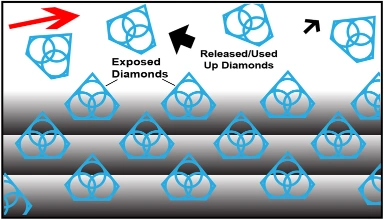
The newly exposed diamonds don’t effect diamonds already working on the material. Unlike many other diamond bonds, diamonds in a SMART CUT® Bond remains sharp and grow sharper with each cut, prolonging product life and consistent performance.
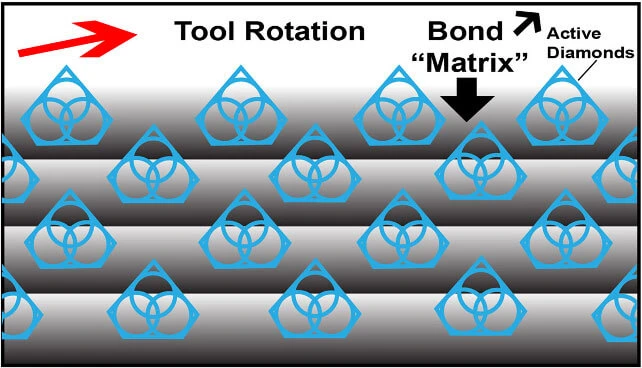
Diamonds or CBN Crystals are activated only at the exposed layer. As Bond Matrix layer begin to wear out, diamonds in a new Bond Matrix layer are immediately activated, substituting the already used up diamond layer. The SMART CUT® Diamond Hybrid Bond makes sure every diamond is in the right place and at the right time, working where you need it most.
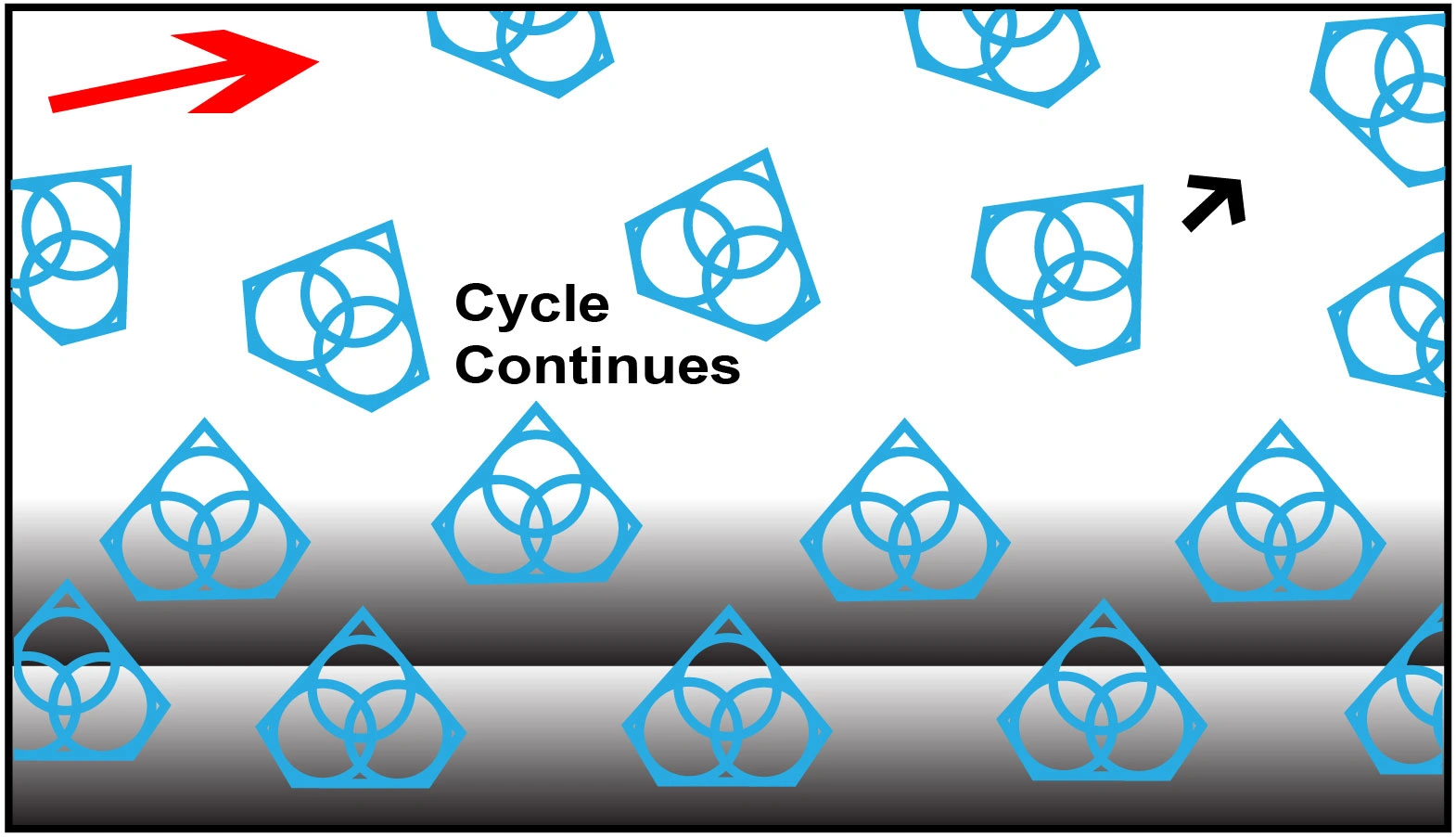
This advanced formulated open diamond bond design insures minimal chipping, fast cut, constant speed of cut, minimal cutting noise, and most important of all, consistent performance.
Sintered (metal bonded) diamond tools have multiple layers of diamonds impregnated inside the metal matrix. Diamonds are furnaces sintered in a matrix made of iron, cobalt, nickel, bronze, copper, tungsten, alloys of these powders or other metals in various combinations. Metal bonded diamond tools are “impregnated” with diamonds. This means that selected diamonds are mixed and sintered with specific metal alloys to achieve the best cutting performance possible on any materials such as sapphire, advanced ceramics, optics, glass, granite, tile and etc. The metal bond surrounding the diamonds must wear away to continuously keep re-exposing the diamonds for the diamond tool to continue cutting. Sintered (metal bonded) diamond tools are recommended for machining hard materials from 45 to 75 on rockwell scale (5 to 9.5 on mohe’s scale of hardness).

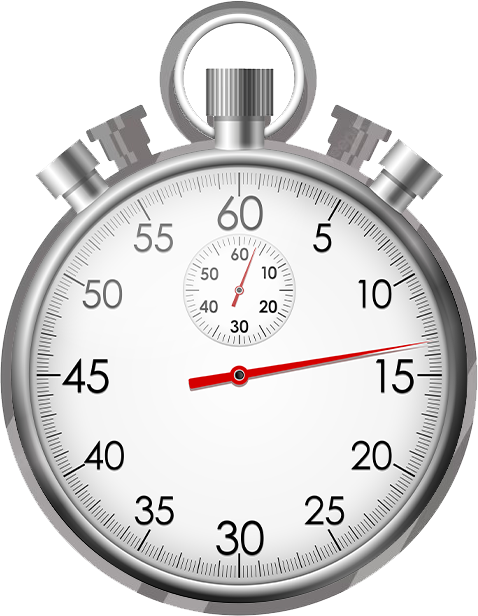
Diamond & CBN tools made utilizing SMART CUT® technology are much more aggressive than your conventional tools. They can cut faster, while still leaving behind a smooth finish free of material deformation.

In most cases tools manufactured utilizing SMART CUT® technology, will outlast other conventional material (sintered), resin, and nickel bonded diamond & CBN tools. SMART CUT® diamond & CBN tools are more sturdy than tools manufactured with conventional technologies. They are capable to retain their form and bond configuration all the way through the tools life.

SMART CUT® Sintered (Metal Bond) Tools have diamonds crystals oriented and evenly positioned inside bond matrix. Unlike Many Other Tool Types, they wear evenly, and are known for their consistency. You will get consistent cutting speed, and overall consistent performance, with minimum amount of dressing even on the hardest to cut materials.
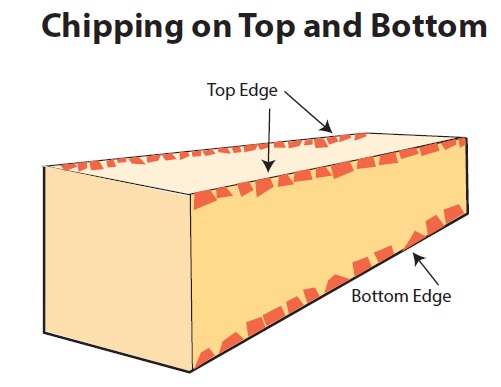
SMART CUT® Sintered (Metal Bond) Tools have diamonds oriented and evenly distributed in a bond matrix. Providing faster, freer cutting action with minimum heat generation. This translates in improved surface finish and minimum chipping.

SMART CUT® Sintered (Metal Bond) Diamond Tools are the best investment you can make! Although they may cost more than some Sintered (Metal Bond) Tools. They will more than pay for themselves in terms of overall performance and provide best Return on Investment.

Only the highest quality synthetic diamonds and raw materials are used in the manufacturing process. The highest quality standards and product consistency is maintained, using sophisticated inspection and measurement equipment.
Optimize your application to ultimate level of efficiency
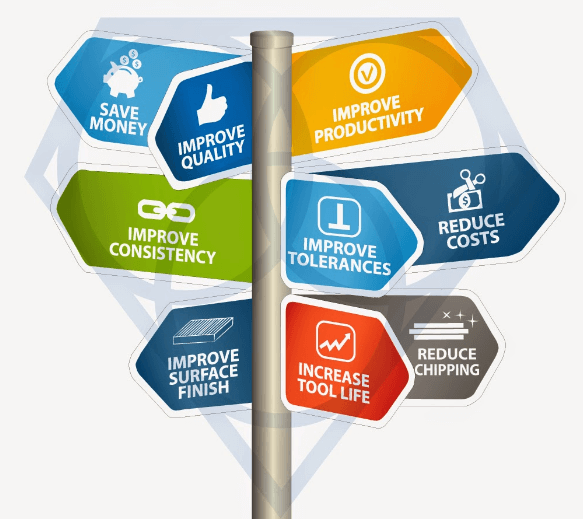

Diamond concentration is a critical parameter in determining the performance characteristics—particularly the cutting efficiency, surface finish, tool life, and heat generation—of sintered metal bond diamond carving points. This refers to the volume of diamond abrasive content embedded within the metal bond matrix, typically expressed as a percentage or relative index. The optimal concentration varies depending on the material being worked, the shape and profile of the carving point, the RPM, feed pressure, and the intricacy of the carving application.
Low Diamond Concentration
Sintered diamond carving points with lower diamond concentration are ideally suited for ultra-hard, dense, and brittle materials such as advanced ceramics, quartz, sapphire, zirconia, and specialty glass. In these applications, material removal occurs primarily through a fracture mechanism—individual diamond particles create localized stress fields that exceed the material’s fracture toughness, chipping away micro-fragments from the surface.
In low-concentration formulations, the diamond particles are spaced farther apart, resulting in higher localized pressure on each diamond particle. This intensified point pressure enhances the ability of each diamond to initiate cracks in hard, brittle materials. While such tools may wear faster than their high-concentration counterparts, they are highly effective in applications where precision, control, and minimized subsurface damage are required.
High Diamond Concentration
Conversely, high diamond concentration sintered carving points are preferred for softer, more ductile, and abrasive materials, such as composites, polymer matrix materials, copper alloys, aluminum, and certain metals. In these scenarios, cutting is governed by a plowing and abrasion mechanism. The higher diamond content allows for more contact points, distributing cutting forces more evenly across the tool surface, reducing unit pressure on each individual diamond.
This results in faster material removal rates, enhanced durability of the tool, and reduced risk of tool glazing. Additionally, for materials prone to plastic deformation or smearing, higher diamond density minimizes the tendency to induce heat-affected zones or deformation layers by reducing the force per diamond contact point.
However, it is important to note that increasing diamond concentration also results in a reduced self-sharpening ability of the carving point. As the tool wears, embedded diamonds may remain in the bond structure longer than necessary unless properly dressed, which can temporarily degrade performance. Therefore, frequent dressing or re-exposing of fresh diamond is recommended, especially when working with intricate or high-precision geometries.

In the context of sintered metal bond diamond carving points, tool thickness—which includes both the diameter of the working tip and the body or shank thickness—directly influences the kerf width, cutting performance, material loss, and overall stability of the tool during operation. While these carving tools do not resemble wafering blades in geometry, the same principles of material removal, rigidity, and control over dimensional accuracy apply.
The kerf, or the width of material removed during carving, is determined by the effective width of the diamond-impregnated portion of the tool, which may range from as small as 0.3 mm to over 3.0 mm, depending on the tool design and intended application. In precision micro-carving or engraving tasks—particularly on intricate parts, fine details, or microelectronic components—minimal kerf width is essential to preserve dimensional integrity and reduce material waste.
Thin Carving Points (Small Tip Diameter / Narrow Kerf)
Tools with very fine diamond tips (e.g., <1.0 mm in diameter) are typically used in applications requiring high precision, minimal material loss, and delicate feature carving, such as microchannels, fine lettering, or detailed relief patterns in ceramics, sapphire, glass, or other hard brittle materials. These tools are essential when the cutting path must be tightly controlled in relation to surface features—similar to aligning a cutting plane precisely on an IC circuit trace.
However, the trade-off with thinner carving points is that they tend to be less rigid, making them more susceptible to deflection, vibration, and breakage under aggressive loads or feed rates. As such, they are best operated at moderate RPMs with light, controlled feed pressure, particularly by skilled technicians or robotic systems designed for micro-fabrication.
Thicker Carving Points (Larger Tip Diameter / Wider Kerf)
Larger diameter or thicker-bodied carving tools provide significantly greater rigidity and durability, making them well-suited for rough carving, deburring, shaping, and edge profiling of larger or denser materials. These tools can withstand higher loads and feed pressures, and are more tolerant of operator variability or inadvertent misuse, making them ideal for educational labs, shared equipment environments, or general-purpose material shaping.
Thicker carving points are also less prone to chatter or flex, especially when used on harder, vibration-sensitive materials or where longer tool extensions are necessary. While they result in wider kerf widths and greater material removal per pass, they offer improved control and reduce the risk of tool failure or part damage in less experienced hands.
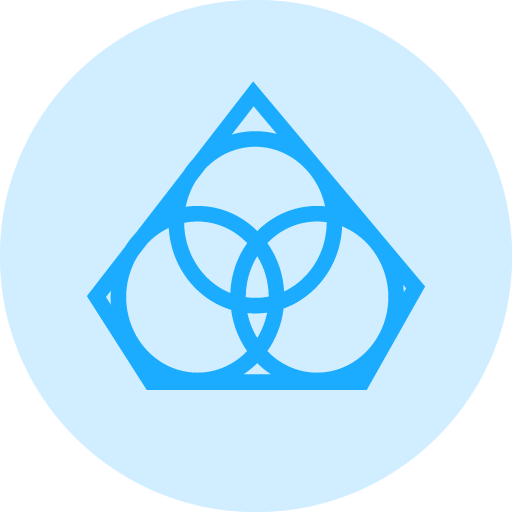
The diamond grit size (also referred to as mesh size) embedded within sintered metal bond diamond carving points has a significant influence on cutting speed, surface finish quality, material removal rate, chipping level, and the extent of subsurface damage. Selecting the appropriate grit size is crucial to achieving the desired balance between aggressiveness of cut and fineness of finish, especially when working on hard, brittle, or intricate surfaces.
Coarse Diamond Grit (Lower Mesh Size)
Sintered carving points containing coarse diamond particles—typically in the 35/50 to 60/80 mesh range—are ideal for applications requiring fast stock removal, such as rough shaping, contour grinding, or bulk material removal on hard ceramics, engineered stone, glass composites, and certain metals.
Larger diamond crystals penetrate deeper into the material and provide more aggressive cutting action, leading to faster carving speeds and higher productivity. However, this comes at the cost of increased chipping, rougher surface finish, and greater subsurface microstructural damage, especially in delicate or brittle materials. These tools are best suited for early stages of shaping where surface finish is not a critical concern.
Fine Diamond Grit (Higher Mesh Size)
For fine detailing, finishing passes, and precision surface work, carving points utilizing fine diamond grit—such as 120/140 mesh or finer (180/200, 220/240, 325/400)—are strongly recommended. These finer particles remove material via a more gradual, refined abrasion mechanism, producing minimal edge chipping, lower thermal/mechanical stress, and smoother surface finishes.
Fine mesh carving points are essential for applications involving intricate patterns, high-tolerance parts, fragile structures, or materials sensitive to cracking, such as sapphire, quartz, and zirconia. While they offer slower material removal rates compared to coarser grits, they greatly reduce the risk of damaging the part or compromising dimensional accuracy.
Balancing Grit Size with Application Needs
Ultimately, the ideal diamond mesh size should be chosen based on the material characteristics, stage of the carving process, machine RPM/load, and the desired finish. In many advanced applications, a multi-step process is used—starting with coarser grit carving points for rough shaping, followed by finer grit tools for detailing and polishing—to optimize both efficiency and quality.

The bond type used in a diamond carving point plays a central role in determining its cutting characteristics, life span, surface finish quality, resistance to heat, and overall suitability for a specific material or application. In diamond carving points, the most common bond types include sintered metal bond, resin bond, electroplated (nickel bond), and brazed bond. Each of these offers distinct advantages and trade-offs depending on the hardness of the workpiece, complexity of the carving, and operational parameters such as feed rate, spindle speed, and cooling.
Sintered metal bond diamond carving points are manufactured by sintering a blend of metal powders with diamond crystals under high pressure and temperature, creating a dense, durable structure. These carving tools are engineered for longevity and are ideal for use on extremely hard, abrasive materials such as alumina, zirconia, silicon carbide, and technical ceramics. Their primary advantage lies in their extended tool life and ability to maintain performance under high loads and continuous-duty operations. However, they tend to generate more heat and require higher cutting forces compared to other bond types. Because the diamond particles are embedded throughout the body of the tool, sintered tools can be dressed periodically to expose new layers of diamond, making them especially valuable for long-term use in industrial environments.
Resin bond diamond carving points, by contrast, are made by mixing diamond abrasives with a polymer-based resin, typically phenolic or polyurethane. These tools produce a smoother, more forgiving cut and are ideal for applications that require a delicate touch, particularly on brittle, heat-sensitive materials such as glass, quartz, sapphire, and other crystals. Resin bonds offer excellent surface finish and produce significantly less heat during carving operations. They are often the bond of choice for applications where chipping, microfracturing, or thermal stress must be avoided. The trade-off is that resin bond carving points wear faster than sintered tools and are generally less suitable for heavy-duty or high-load operations.
Electroplated diamond carving points, also referred to as nickel-bonded tools, consist of a single exposed layer of diamond particles attached to the surface of the tool using an electroplating process. These tools offer extremely aggressive, sharp cutting action and are ideal for rapid material removal, shaping, and profiling. They are particularly effective in soft-to-medium-hard materials and are widely used in applications where intricate detail and fast results are required. Electroplated tools do not require dressing, as the diamonds are fully exposed from the beginning of the tool’s life. However, they have a much shorter life expectancy, as there is no diamond layer beneath the plated surface. Once the diamond layer is worn, the tool must be replaced.
Brazed bond diamond carving points represent a more recent advancement and provide an excellent balance between durability and aggressiveness. In brazed tools, diamond particles are fused directly to the surface of the tool body using a high-temperature brazing alloy, typically silver-based. This creates a strong mechanical bond that allows a higher exposure of each diamond crystal compared to electroplating. As a result, brazed carving points offer faster cutting speeds, better debris clearance, and improved heat dissipation. They are especially well suited for hard-to-machine materials such as composites, carbon fiber, ceramics, and natural stone. The diamonds are strongly retained yet highly exposed, providing aggressive cutting performance while still maintaining reasonable tool life. Brazed tools do not have embedded diamonds throughout the body like sintered tools, so once the surface diamonds wear out, the tool cannot be dressed or renewed.
Selecting the optimal bond type for diamond carving points requires consideration of material hardness, fragility, thermal sensitivity, part geometry, and production volume. Sintered bond is preferred for high-load industrial use and longevity on abrasive materials. Resin bond excels in fine finishing and delicate work where surface integrity is critical. Electroplated tools are unmatched in detail carving and fast, light-duty operations, while brazed bond carving points offer a high-performance solution for applications demanding both speed and durability. Matching the correct bond type to the application ensures better results, reduced tool wear, improved part quality, and maximum return on investment.
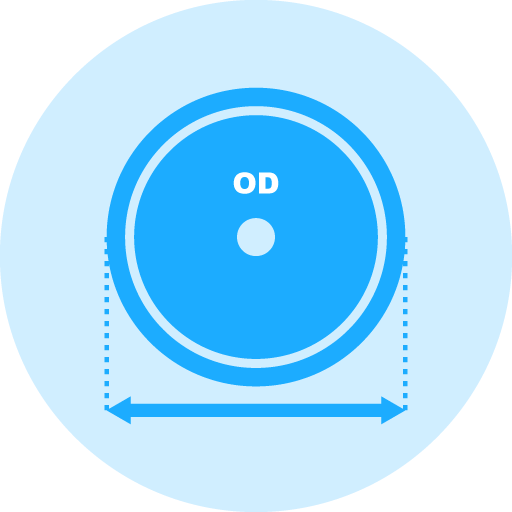
The outside diameter or head size of sintered metal bond diamond carving points plays a significant role in determining their rigidity, stability, cutting depth, access to tight areas, and overall performance. While carving points do not follow the same standard diameter sizes as wafering blades, the principles of tool head dimension selection remain just as important—particularly in high-precision or deep-carving applications.
Smaller Diameter Carving Points
Diamond carving tools with smaller head diameters, typically ranging from 0.5 mm to 5 mm, are ideal for fine detail work, tight corners, internal radii, engraving, and micro-shaping operations. Their compact profile allows precise access to intricate geometries and confined spaces on parts made of ceramics, composites, or hard crystals.
However, smaller diameter tools are generally more flexible and prone to deflection, particularly under high lateral loads or aggressive feed rates. This can lead to dimensional inaccuracy, increased tool chatter, or uneven surface finishes, especially on denser or more rigid materials. As such, they are best used at lower RPMs and feed pressures, with careful operator control to maintain precision and tool life.
Larger Diameter Carving Points
Conversely, sintered carving points with larger tool head diameters—ranging from 6 mm to 25 mm or more, depending on the application—offer increased rigidity, deeper cutting capability, and improved heat dissipation. These tools are typically employed in bulk material removal, contouring of larger surfaces, and rough shaping operations on materials such as ceramic matrix composites, stone, or technical glasses.
The added mass and structural stiffness of larger diameter carving heads allow them to withstand higher cutting forces and rotational speeds, making them more suitable for high-load, high-volume production scenarios. However, due to their larger contact area and greater cutting surface, they may generate more heat and friction, necessitating the use of appropriate coolants or lubrication.
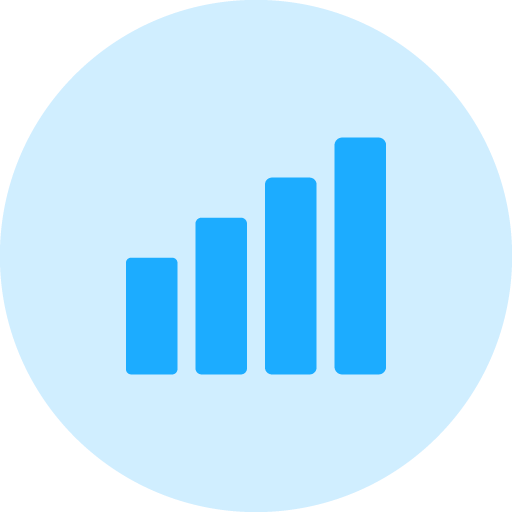
In the use of sintered metal bond diamond carving points, the applied feed rate and load are critical variables that directly affect cutting efficiency, surface finish, tool life, and the risk of part damage. Unlike wafering blades, carving tools rely on operator-controlled or programmed pressure, often in combination with RPM, coolant flow, and tool geometry to manage the contact force between the tool and the workpiece.
Harder, denser materials such as ceramics, quartz, and engineered stone generally tolerate higher feed rates and contact pressure, especially when using coarser grit tools and proper coolant. These materials resist deformation, allowing more aggressive cutting without risk of excessive chipping—provided the tool is rigid and well-cooled.
Brittle, delicate, or layered materials—such as fused silica, silicon substrates, or brittle glasses—require lower feed pressures and slower engagement speeds to avoid microfracturing and subsurface damage. In these cases, finer grit tools and gentle pressure are essential, often paired with continuous coolant to minimize thermal and mechanical stress.
Several factors influence the ideal feed rate for diamond carving points, including:
Spindle speed: Higher RPM generally allows lighter feed pressure while maintaining effective material removal.
Tool diameter and shape: Smaller tools require lighter pressure to avoid breakage or deflection.
Workpiece geometry: Complex shapes and sharp edges demand reduced feed force to maintain control.
Fixturing: Rigid, vibration-free clamping ensures stable tool engagement and accurate cuts.
Coolant use: Essential to prevent overheating and maintain cutting efficiency at any feed rate.
Improper feed pressure can result in glazing (if too light) or premature bond wear and tool failure (if too heavy). The best results are achieved when feed rate and load are matched to the material, tool type, and operational conditions. Skilled users rely on visual, tactile, and acoustic feedback; in automated systems, these values should be carefully programmed and optimized per application.

Bond hardness refers to the ability of the metal bond matrix to retain diamond particles during operation. It is one of the most critical factors influencing the cutting performance, tool longevity, and frequency of dressing for sintered metal bond diamond carving points. The selection of an appropriate bond hardness is essential to ensure efficient material removal, preserve tool life, and maintain consistent performance throughout the carving process.
As the hardness of the bond increases, the metal matrix becomes more resistant to wear and is able to hold the diamond particles more securely for longer periods. This typically results in extended tool life, particularly in applications where aggressive material contact and long carving durations are required. However, the trade-off is a slower cutting rate and a reduced self-sharpening effect, as the hard bond does not release dull or worn diamond particles as readily. This can lead to glazing—where the surface of the tool becomes smooth and less effective—necessitating frequent dressing to restore cutting performance.
Conversely, a softer bond matrix allows for faster exposure of new, sharp diamond particles as the worn crystals are released more readily during use. This promotes faster material removal rates and consistent cutting action, especially beneficial when working on extremely hard and dense materials such as sapphire, alumina, zirconia, or certain technical ceramics. However, if the bond is too soft for the specific material or application, it may prematurely release diamonds, leading to rapid tool wear and reduced carving point life.

The rotational speed (RPM) at which sintered metal bond diamond carving points are operated plays a central role in determining cutting performance, surface quality, tool life, and thermal load. Proper RPM selection is essential to balance material removal rate with precision, particularly when working on ultra-hard, brittle, or heat-sensitive materials.
Diamond carving points are typically used across a broad speed range, from 500 RPM to over 35,000 RPM, depending on the tool diameter, grit size, material being processed, and the capabilities of the spindle or handpiece. Harder and denser materials, such as sapphire, silicon carbide, and alumina, generally benefit from higher RPMs, as increased speed enhances cutting efficiency and reduces the force required per contact point. However, sufficient coolant must be used to manage the increased heat generation.
By contrast, brittle and fragile materials—such as silicon wafers, fused silica, gallium arsenide, or certain crystals—require lower rotational speeds to minimize thermal cracking, chipping, and subsurface damage. For these applications, fine grit carving points operated at moderate to low RPMs provide better control and preserve material integrity.
Equipment limitations also play a role in defining RPM ranges. Low-speed rotary tools or micromotor systems typically operate between 0 and 5,000 RPM, suitable for precision work and fine detailing. High-speed spindles, CNC machines, or air turbines may offer speeds from 5,000 to 35,000 RPM or higher, enabling faster material removal for suitable applications.
Optimal RPM depends on the material hardness, brittleness, tool diameter, grit size, coolant use, and operator control. Excessively low RPMs may cause glazing or inefficient cutting, while too high a speed can result in tool overheating, accelerated wear, or damage to delicate substrates. Therefore, establishing a recommended RPM range for each application and tool type is key to achieving consistent and reliable results.



Signup for email offers, updates, and more

UKAM Industrial Superhard Tools is a U.S. High Technology, Specialty Diamond Tool & Equipment manufacturer. We specialize in producing ultra thin & high precision cutting blades and precision cutting machines diamond drills, diamond micro tools, standard & custom advanced industrial diamond tools and consumables.
Shipping Methods

Safe & Secure Payments

© Copyright 1990-2025. UKAM Industrial Superhard Tools – Terms of Use
No products in the Quote Basket.
No account yet?
Create an AccountSign up to receive exclusive usage recommendations, Illustrated Trouble Shooting Guides & Sales